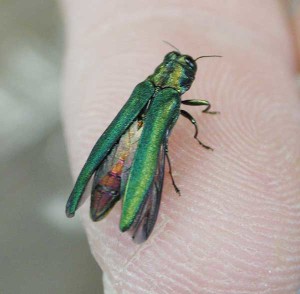Emerald Ash Borer Update
01 Feb 2015
 What we've learned about the Emerald Ash Borer
What we've learned about the Emerald Ash Borer
This spring, as Boulder County residents anticipate the second season of defense against the Emerald Ash Borer (EAB), it’s a good time to take stock of what we have learned since this devastating insect was first discovered in Boulder, Colo., 17 months or so ago.
Much of the information disseminated last year by public entities and private companies was based on the decade-and-a-half of prior experience garnered in the upper Midwest, the first U.S. region to be attacked by the EAB. Now that we in Boulder County have more than one EAB season under our belts, we know a bit more based on local observations.
- The extent of known infestation is still limited to the city of Boulder, but has spread north beyond Jay Road, south all the way to Greenbriar Boulevard, and east to just beyond 55th Street. The western edge of the City’s delimitation survey still runs roughly along Folsom Street. But the actual infestation is presumed by Boulder City Forester Kathleen Alexander to have spread well beyond these lines. EAB is very hard to detect in its early stages, so it’s very hard to know just how far these destructive insects have traveled.
- The time it takes for our ash trees to show signs of attack (thinning, dieback, woodpecker holes, exposed galleries, etc.) seems to be shorter here than that observed in the Midwest. In infestations there, it took about four or five years before such signs became apparent. Here, according to Boulder City Forestry, it is more like two or three. This is certainly due, at least in part, to the fact that we have more severe climatic stresses here (primarily droughts and substantial temperature drops, but also flooding in 2013). These stresses not only exacerbate the harm caused by EAB, they can also damage trees in ways that mimic the damage (canopy thinning and bark cracking) done by the EAB. Thus, many trees in Front Range areas not yet under attack look like ones that have been attacked. This is causing confusion in the marketplace, and unethical opportunism among some tree companies servicing cities well beyond the infestation.
- There is hope that biological controls may contribute to slowing the spread and lessening the damage done by EAB. Boulder City Forestry released one type of parasitic wasp last summer in dense stands of volunteer ash along streambeds. They will release more of the same, as well as a second variety, this coming season. EAB evolved in ecosystems that included these natural parasites, which is likely the reason why the borers coexist with, rather than destroy, ash trees in parts of Asia. These wasps will parasitize larvae and eggs, respectively, and it is hoped that their numbers will grow with the population of borers.












